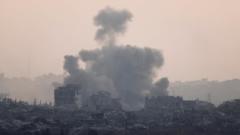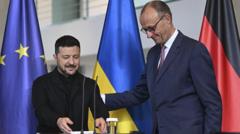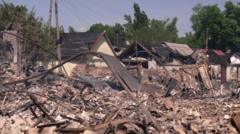The ongoing war in Ukraine faces a significant shift as Russian forces employ fibre optic drones, rendering previous defense systems largely ineffective. Towns like Rodynske are devastated by air assaults, while Ukrainian soldiers adapt to this new threat, highlighting the increasingly perilous nature of the battlefield.**
The Game-Changing Drone Warfare in Ukraine**

The Game-Changing Drone Warfare in Ukraine**
As Russia intensifies its drone strikes in Ukraine, the conflict enters a new and more dangerous phase marked by advanced fibre optic technology.**
The ongoing conflict in Ukraine is witnessing a dramatic transformation with the advent of fibre optic drones, which have altered the dynamics of warfare on the ground. In a recent report from Rodynske, a town severely affected by the escalating attacks, the desolation is palpable. A 250kg glide bomb targeting the administrative building devastated several residential blocks, leaving a lingering acrid smell in the air. Although the attack occurred a day prior, remnants of the destruction continue to smolder, set against the backdrop of distant artillery fire.
Rodynske, situated north of the strategic city of Pokrovsk, has found itself in the line of fire as Russian forces employ new tactics to encircle the area, aiming to cut off vital supply routes. Recent weeks have seen a marked escalation in hostilities, underscoring the urgency of diplomatic efforts that have failed to yield a ceasefire.
During a tense visit, reporters were alerted to the presence of Russian drones hovering ominously overhead, signaling a grave danger. As the sound of drone propellers filled the air, frantic efforts to seek shelter intensified. This new aerial threat is being increasingly deployed by Russian forces, taking advantage of newly established positions closer to the front lines.
Further travels led to Bilytske, where destruction was evident in the wake of a recent missile strike. Residents, like 61-year-old Svitlana, recount the escalating violence, indicating a shift from distant threats to direct attacks on their homes. The soldiers, meanwhile, are under extraordinary pressure, adapting to the increasing intensity of assaults from all fronts.
Key to this new phase of warfare are fibre optic drones, equipped with advanced technology that allows for precise control and engagement with targets. Unlike traditional drones, which rely on radio frequencies susceptible to jamming, these drones use a physical cable for command and communication, presenting a significant challenge for Ukrainian defense systems that have historically relied on electronic warfare tactics.
As mentioned by drone engineers from the Ukrainian military, the deployment of fibre optic drones by Russia has far outpaced their own efforts. Not only are these drones capable of penetrating lower altitudes, but they also allow for reconnaissance missions with enhanced accuracy. This technological edge has significant implications for troop deployments, with soldiers facing increased risk during transitions and logistics.
Patience and perseverance are paramount on the battlefield, as exemplified by the soldiers stationed in the trenches, who now experience extended rotations due to the relentless threat from drones. The psychological toll of this prolonged engagement is evident, with soldiers expressing a deep sense of anxiety regarding their lives and the impact on their families back home.
Ukraine’s fight remains fierce, but there are clear challenges as it confronts a larger, more technologically advanced adversary. While recent Russian advances in the Donetsk region present a formidable challenge, the resilience of Ukrainian forces and their demand for greater support continues to be a beacon of hope against the backdrop of ongoing conflict. With manpower increasingly stretched and frontline realities shifting, the fight for Ukraine is far from over.



















